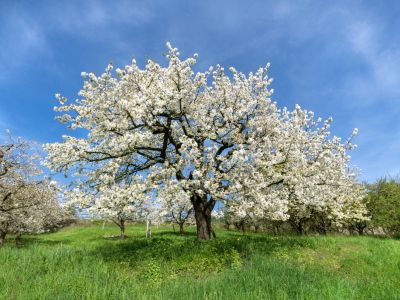The best strategy is to determine where flowering trees could be used effectively and only then consider the proper variety. Experts recommend that someone picking among the types of flowering trees take many factors into account when picking a tree. Consider a tree’s mature size, season of bloom, and duration of blossoms. In addition, make sure the tree’s cultural requirements match up with your environment and preferences.
Picking a Tree with White Flowers
As you make your own shortlist, here are 10 of our favorite flowering trees that engage us with their white flowers. Remember to consider the site exposure and hardiness zone as you work your way through the list.
1. Kousa dogwood (Cornus kousa)
With its excellent disease resistance and tolerance of cold climates, Kousa dogwood is a popular little flowering tree. It usually stays less than 30 feet (10 m.), but this deciduous tree astonishes with showy white bract “flowers” in May and June. After that? Showy red fruit develops in summer.
2. Star magnolia (Magnolia stellata)
This is the classic small tree with large white flowers. Star magnolia is cold hardy to zone 4 but needs full sun and protection from winds to thrive. In March, the huge white flowers, with 12 to 18 petals, make this the showiest tree in the garden. Perfect for small yards, it only grows to 20 feet (6 m.).
3. Catalpa (Catalpa speciosa)
Here’s a large tree, up to 60 feet (18 m.), that offers huge and showy white flowers in early summer with a special touch: each flower is marked with purple or yellow near the throat. After that, long green pods form and decorate the tree. The fast-growing catalpa trees are hardy in USDA hardiness zones 4 to 8.
4. Flowering Crabapple (Malus)
Nobody can deny the beauty of crabapples with showy white spring flowers. Some cultivars are small, others bigger, so it’s likely you can find something to fit your site. Pick a tree with attractive fruit that hangs on the branches all winter, providing food for wildlife. Disease-resistant cultivars are your best bet.
5. Smoketree (Cotinus obovatus)
If you’ve never seen a smoketree, you’ll be blown away by their delicate blossoms that resemble puffs of smoke. Flowering begins in June and lasts for several weeks. Smoketree grows to 30 feet (9 m.) tall and prefers sunny locations.
More White Flowering Trees
6. Serviceberry (Amelanchier canadensis)
Serviceberry is a 40 foot (12 m.) tree that blooms very early in the spring. It turns almost overnight from skeletal to lush. In early spring, it becomes a beautiful tree with masses of small white clustered flowers. On their heels come purple, edible berries that attract birds. The final act of the serviceberry is its fall display in yellow, gold, or red.
7. Japanese Tree Lilac (Syringa reticulata)
Not all white flowers look alike. The flowers that cover the small Japanese tree lilac are small and plentiful, frothing like lilac flowers over the reddish brown trunk. It has lilac-type white blooms in midsummer and attractive reddish brown peeling bark on younger stems. For best bloom, plant in full sun in zones down to zone 3.
8. Hawthorn (Crataegus spp.)
If you are looking for a medium-sized tree with small white flowers, hawthorn may be a good one to consider. In May or June, the tree fills with clusters of tiny, white, rose-like flowers. They develop into berries in late summer and fall. Trees can grow to 50 feet (15 m.) and are hardy to at least zone 4.
9. Seven-sons flowering tree (Hepatacodium micronoides)
A fragrant tree with white flowers, the seven sons flower blooms quite late – in late August. Its lush crop of clusters of white flowers delight pollinators such as bees, butterflies, and wasps. The tree’s sepals turn rose-pink after blossoming and provide extra ornamental interest. Seven sons flower grows to 30 feet (9 m.) in USDA hardiness zones 5 to 9.
10. Flowering Mazzard cherry (Prunus sp.)
Flowering cherries are lovely flowering trees, but most offer pink blossoms. A few spectacular specimens offer white flowers, like the double-flowered Mazzard cherry. Its spring blossom show is short but stunning and is followed by cherries that are beloved by wild birds.
